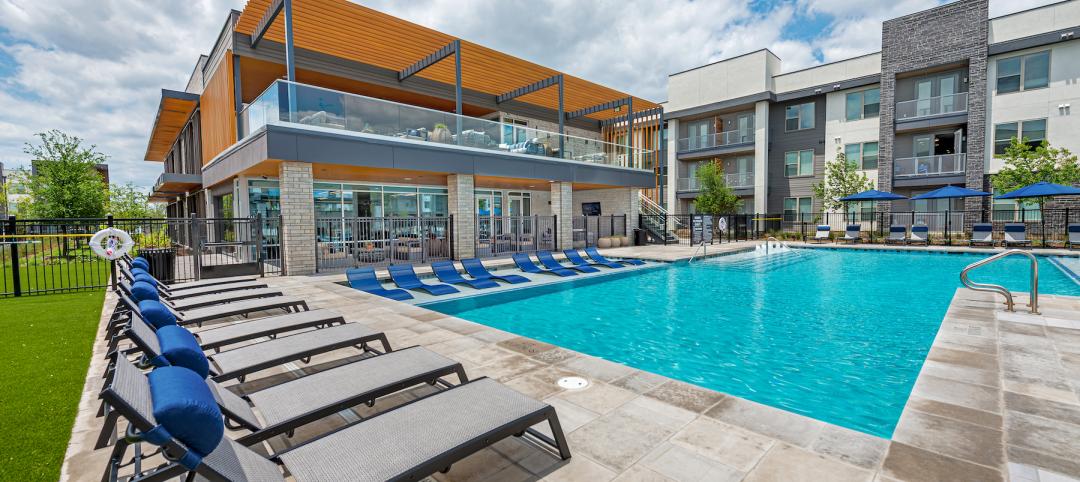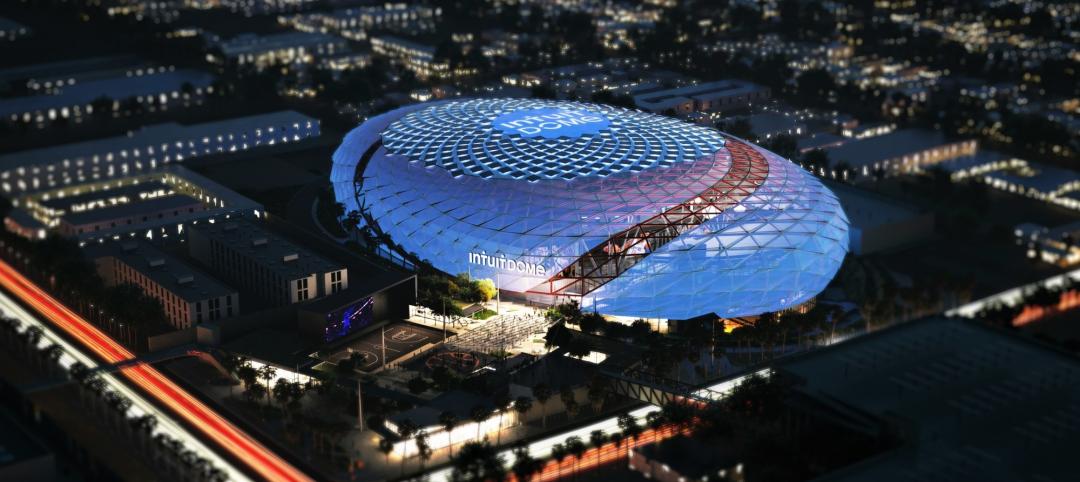From its founding in 1979, the Mid-Ohio Foodbank has performed yeoman’s service in receiving, sorting, and distributing food to tens of thousands of Ohio families.
By 2006, however, it had outgrown its 71,000-sf facility. The loading docks were no longer up to the task of shipping tens of millions of pounds of food a year. Offices were cramped. There wasn’t enough space for training and volunteer activities. It was time for a change—not merely a change of venue, but one that held the prospect of transforming the whole organization for the better.
Matt Habash, Mid-Ohio’s president and CEO, and his board set four key goals for the project: 1) Showcase the food bank’s mission; 2) Foster cultural change in the organization; 3) Provide flexibility, adaptability, and expandability; and 4) Make the building sustainable.
After touring a number of food banks in the Midwest, holding design charrettes with Mid-Ohio staff and food bank leaders from around the country, and conducting an analysis of the existing facility, a Building Team assembled by Columbus, Ohio-based Rogers Krajnak Architects concluded that the food bank had to look for a new location.
With a construction budget of only $9 million, the team wisely chose to renovate a 190,000-sf mattress factory into a modern, multifunctional food bank that would exceed Habash’s four-goal mandate.
Showcasing the mission. The Building Team organized the building so that visitors get a sense of the food bank’s mission as they pass a food garden on their way to the main lobby. The central two-story, skylit lobby provides views of the many volunteers sorting and packing food, while a double-height glass bay at the end of the lobby offers a view into the drygoods racking area, where thousands of pallets of food are stacked. Making the function of the building more apparent to the public can have a positive impact on fundraising and volunteering.
Designing for flexibility and growth. The 125,000-sf warehouse space was designed to be able to accommodate 4,300 pallet positions. The Building Team devised a way to enable the racking system to be expandable by installing additional rows of racks within the existing width of the aisles. Freezers and refrigerators take up 12,500 sf; along with warehouse racking, this space is designed for future expansion.
Fostering organizational change. The move to a new building was viewed by management as an opportunity to create a more egalitarian and collaborative work environment and enhance communication between the office and warehouse staffs.
The Building Team responded by creating administration areas in open-office spaces, mostly on the upper-level mezzanine. Perimeter offices have no doors but do have lots of glass on interior walls for enhanced daylighting and visibility.
Another organizational goal was the desire to engage the community more fully. In the past year, the new food bank’s meeting/conference spaces have hosted more than 1,500 meetings for volunteer groups, corporate workshops, training sessions, and similar outreach activities. The 400-seat community room has advanced A/V capability as well as a fully equipped demonstration and commercial catering kitchen where nutrition education programs are conducted.
Achieving sustainability. Although the early goal was to gain LEED Silver certification, the project earned Gold status (under LEED NC 2.2) through such strategies as the reuse of materials from the old building (metal liner panels, insulation, concrete), installation of bioswales, and the use of climate-appropriate landscaping. Operable windows, exterior sunshades, and metal panel building fins bring daylight into the building while controlling glare and heat buildup
Other LEED benchmarks: 30% water reduction via water-efficient fixtures, 95% diversion of construction waste from landfill by GC Ruscilli Construction, and over 20% recycled content in construction materials (more than 30% regionally sourced).
Currently, the Mid-Ohio Foodbank distributes over 38 million pounds of food a year to over 500 partner agencies in 20 Ohio counties—enough food to provide 55,000 meals a day for hungry Ohioans. More than 10,000 volunteers contribute 38,000 hours of service annually.
The judges were unanimous in granting a Platinum Award, the highest honor, to the project. “The interior is so functional. There’s a nice blend of spaces—working space, community space, office space,” said K. Nam Shiu, SE, PE, MISE, VP of Walker Restoration Consultants, Elgin, Ill.
The most compelling aspect of this project is how the Building Team took a nondescript building and turned it into an elegant and highly functional community asset. As Martha Bell, FAIA, principal, Tilton, Kelly + Bell, Chicago, puts it, “The team took a plain box and transformed it. It works on every level. This is a great model for this type of building.”
PROJECT SUMMARY
Building Team
Submitting firm: Rogers Krajnak Architects, Inc. (architect, interiors)
Owner/developer: Mid-Ohio Foodbank
MEP/fire protection engineer: Korda
Structural engineer: Shelley Metz Baumann Hawk, Inc.
GC: Ruscilli Construction Co.
Landscape architect: Kinzleman Kline Gossman
LEED consultant: Heapy Engineering
General Information
Size: 204,700 gsf (including 14,763 sf new interior construction)
Construction cost: $9.0 million
Construction period: June 2008 to September 2009
Delivery method: Design-bid-build
Related Stories
Sponsored | Glass and Glazing | Oct 1, 2021
Seizing the Daylight with BIPV Glass
Glass has always been an idea generator. Now, it’s also a clean energy generator.
Architects | Sep 30, 2021
Riding the great AEC resignation wave
More people than ever are reconsidering what work and career mean. What can AEC firms do to recruit and retain workers in this changing workplace environment? Karl Feldman, Partner with Hinge Marketing, discusses ideas and strategies with BD+C's John Caulfield in this exclusive interview for HorizonTV.
Glass and Glazing | Sep 30, 2021
Plans move forward on Central Place Sydney, duel towers with an AI-driven façade system
SOM and Fender Katsalidis are designing the project.
Architects | Sep 28, 2021
Hoffmann Architects Welcomes Travis Heim as Senior Staff Architect
Hoffmann Architects, an architecture and engineering firm specializing in the rehabilitation of building exteriors, announces that Travis Heim has joined the New York office as Senior Staff Architect.
AEC Business Innovation | Sep 28, 2021
Getting diversity, equity, and inclusion going in AEC firms
As a professional services organization built on attracting the best and brightest talent, VIATechnik relies on finding new ways to do just that. Here are some tips that we’ve learned through our diversity, equity, and inclusion (DE&I) journey.
Multifamily Housing | Sep 22, 2021
Designing for the ‘missing middle’ in multifamily housing
Multifamily housing expert Patrick Winters, AIA, discusses a neglected segment of the market: the "missing middle."
Multifamily Housing | Sep 22, 2021
11 notable multifamily projects to debut in 2021
A residence for older LGBTQ+ persons, a P3 student housing building, and a converted masonic lodge highlight the multifamily developments to debut this year.
Data Centers | Sep 22, 2021
Wasted energy from data centers could power nearby buildings
A Canadian architecture firm comes up with a concept for a community that’s part of a direct-current microgrid.
Hotel Facilities | Sep 22, 2021
Will hotel developers finally embrace modular construction?
Last May, MiTek, a construction software and building services company that’s part of Warren Buffett’s Berkshire Hathaway conglomerate, formed a partnership with Danny Forster & Architecture to promote modular design and construction.
Arenas | Sep 20, 2021
LA Clippers unveil $1.8 billion Intuit Dome
AECOM is the lead designer for the project.

















